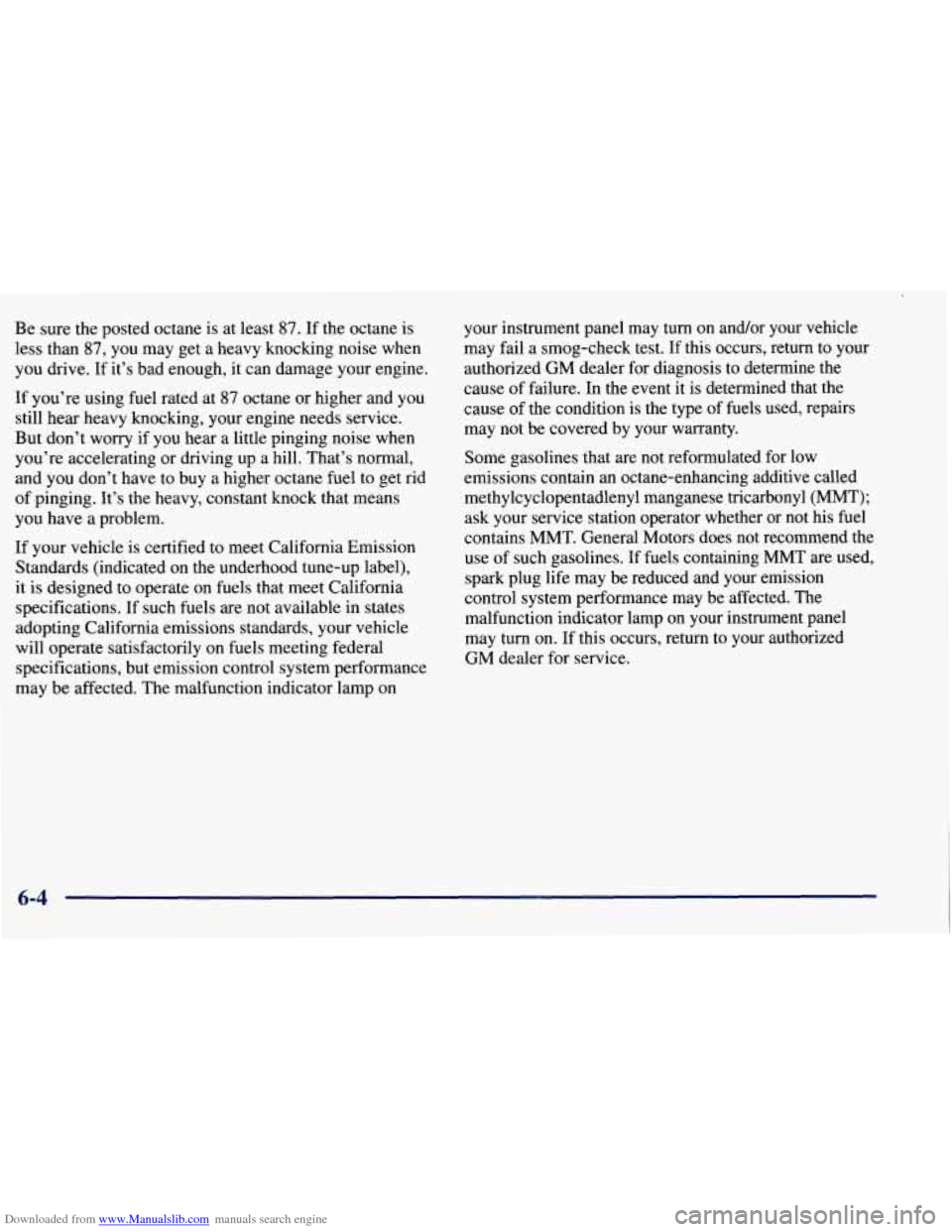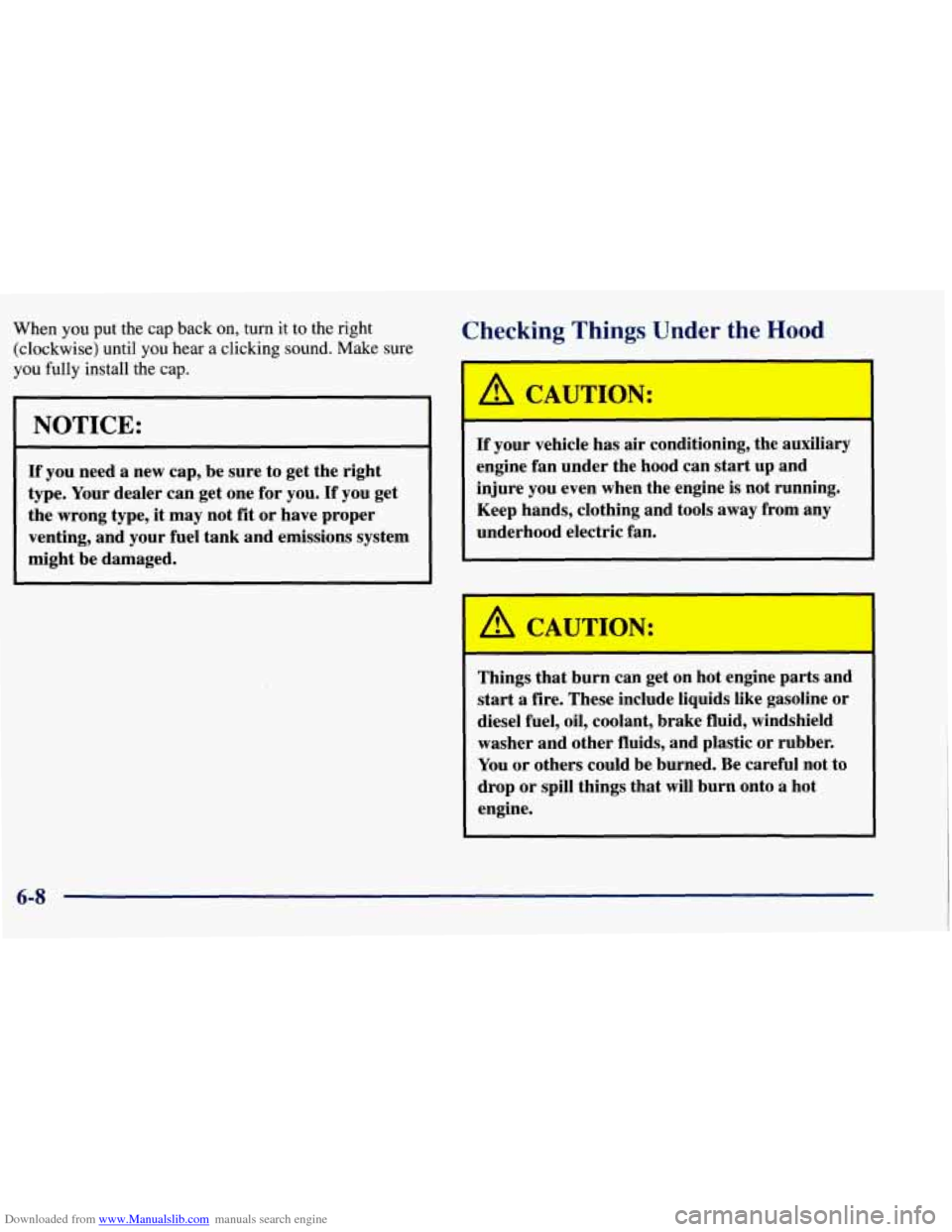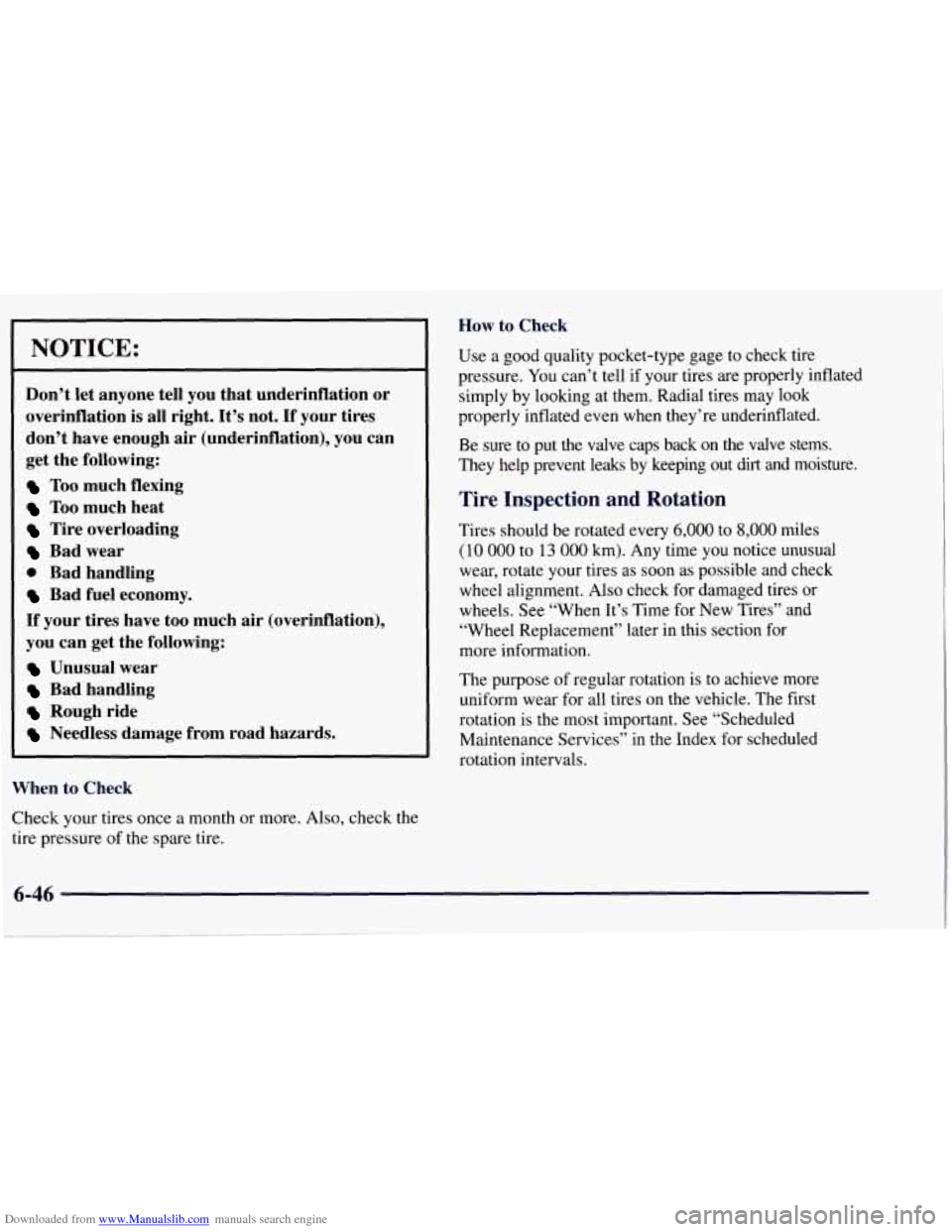Page 283 of 433

Downloaded from www.Manualslib.com manuals search engine Be sure the posted octane is at least 87. If the octane is
less than
87, you may get a heavy knocking noise when
you drive. If it’s bad enough, it can damage your engine.
If you’re using fuel rated at
87 octane or higher and you
still hear heavy knocking, your engine needs service.
But don’t worry if you hear a little pinging noise when
you’re accelerating or driving up a hill. That’s normal,
and you don’t have to buy a higher octane fuel to get rid
of pinging. It’s the heavy, constant knock that means
you have a problem.
If your vehicle is certified to meet California Emission
Standards (indicated on the underhood tune-up label),
it is designed to operate on fuels that meet California
specifications. If such fuels are not available in states
adopting California emissions standards, your vehicle
will operate satisfactorily on fuels meeting federal
specifications, but emission control system performance
may be affected. The malfunction indicator lamp on your instrument
panel may
turn on and/or your vehicle
may fail a smog-check test. If this occurs, return to your
authorized GM dealer for diagnosis to determine the
cause of failure. In the event it is determined that the
cause of the condition is the type of fuels used, repairs
may not be covered by your warranty.
Some gasolines that are not reformulated for low
emissions contain an octane-enhancing additive called
methylcyclopentadlenyl manganese tricarbonyl (MMT);
ask your service station operator whether or not his fuel
contains
MMT. General Motors does not recommend the
use of such gasolines. If fuels containing MMT are used,
spark plug life may be reduced and your emission
control system performance may be affected. The
malfunction indicator lamp on your instrument panel
may turn on. If this occurs, return to your authorized
GM dealer for service.
6-4
Page 287 of 433

Downloaded from www.Manualslib.com manuals search engine When you put the cap back on, turn it to the right
(clockwise) until you hear a clicking sound.
Make sure
you fully install the cap.
NOTICE:
If you need a new cap, be sure to get the right
type. Your dealer can get one for you.
If you get
the wrong type, it may not
fit or have proper
venting, and your fuel tank and emissions system
might be damaged.
Checking Things Under the Hood
'
A CAUTION:
If your vehicle has air conditioning, the auxiliary
engine fan under
the hood can start up and
injure you even when the engine is not running.
Keep hands, clothing and tools
away from any
underhood electric fan.
A CAUTION:
I I
Things that burn can get on hot engine parts and
start a fire. These include liquids like gasoline or
diesel fuel, oil, coolant, brake fluid, windshield
washer and other fluids, and plastic or rubber.
You or others could be burned. Be careful not to
drop or spill things that will burn onto a hot
engine.
6-8
Page 325 of 433

Downloaded from www.Manualslib.com manuals search engine NOTICE:
Don’t let anyone tell you that underinflation or
overinflation is all right. It’s not.
If your tires
don’t have enough air (underinflation), you can
get the following:
Too much flexing
Too much heat
Tire overloading
Bad wear
0 Bad handling
Bad fuel economy.
If your tires have too much air (overinflation),
you can get the following:
Unusual wear
Bad handling
Rough ride
Needless damage from road hazards.
When to Check
Check your tires once a month or more. Also, check the
tire pressure of the spare tire.
How to Check
Use a good quality pocket-type gage to check tire
pressure. You can’t tell
if your tires are properly inflated
simply by looking at them. Radial tires may look
properly inflated even when they’re underinflated.
Be sure to put the valve caps back on the valve stems.
They help prevent
leaks by keeping out dirt and moisture.
Tire Inspection and Rotation
Tires should be rotated every 6,000 to 8,000 miles
(10 000 to 13 000 km). Any time you notice unusual
wear, rotate your tires as soon as possible and check
wheel alignment. Also check for damaged tires or
wheels. See “When It’s Time for New Tires” and
“Wheel Replacement” later in this section for
more information.
The purpose
of regular rotation is to achieve more
uniform wear for all tires on the vehicle. The first
rotation is the most important. See “Scheduled
Maintenance Services” in the Index for scheduled
rotation intervals.
Page 348 of 433
Downloaded from www.Manualslib.com manuals search engine Capacities and Specifications
Please refer to “Recommended Fluids and Lubricants”
in the Index for more information.
Type
RPO Code
VIN Code
Fuel System
Engine Identification -- Gasoline Engines
Engine “VORTEC” “VORTEC”
5700 7400
V8 V8
L3 1 L29
R J
SFI* SFI*
*Sequential Fuel Injection
Wheels and Tires
MODEL DESCRIPTION
C 1500 5 bolts ( 14 mm)
K 1500, 6 bolts (14 mm)
C-IS
2500
TORQUE
(190 Nam)
(190 N-m) 140 lb-ft
140 lb-ft
C-K 2500 8 bolts ( 14 mm) 140 lb-ft
(190 N-m)
Tire Pressure See the Certificationmire label on
the rear edge of the driver’s door
or the incomplete vehicle document in the cab.
6-69
Page 349 of 433

Downloaded from www.Manualslib.com manuals search engine Normal Maintenance Replacement Parts -- Gasoline Engines
Replacement part numbers listed in this section are based on the latest information available at the time of printing,
and are subject to change. If a part listed in this manual is not the same as the part used in your vehicle when
it was
built, or if you have any questions, please contact your GM truck dealer.
Engine
“VORTEC” 5700
VIN R
Oil Filter AC Type PF1218f
Air Cleaner Filter AC Type A1300C
Spark Plugs
AC Type 4 1-932
Spark Plug Gap 0.060
in. (1.52 mm)
Fuel Filter AC Type GF626
Wiper Blades (Front) GM Part No. 22154886
Wiper Blade Type (Front) Trico
Wiper Blade Length (Front) 18 inches (45.0 cm)
Wiper Blade (Rear) GM Part
No. 22154396
Wiper Blade Type (Rear) Trico
Wiper Blade Length (Rear) 14 inches (35.5 cm)
“four-Wheel-Drive Vehicles
-- use a PF52 oil filter.
‘VORTEC” 7400
J
AC Type PF1218
AC Type A1300C AC Type 41-932
0.060 in. (1.52 mm)
AC Type GF626
GM Part
No. 22154886
Trico
18 inches
(45.0 cm)
GM Part No. 22154396
Trico
14 inches (35.5 cm)
Page 351 of 433
Downloaded from www.Manualslib.com manuals search engine Fuel Tank Capacity (Approximate)
TYPE QUANTITY
GasolineDiesel
Utility
- Standard
Suburban
- Standard
30 Gallons (1 13 L)
42 Gallons (159 L)
Air Conditioning Refrigerants
Not all air conditioning refrigerants are the same.
If the air conditioning system in your vehicle needs
refrigerant, be sure the proper refrigerant is used.
If you’re not sure, ask your GM dealer.
See refrigerant charge label under the hood for charge
capacity information and requirements.
6-72